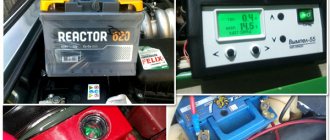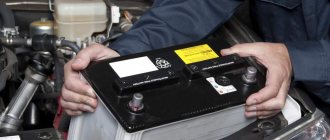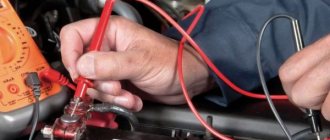About, how to charge a car battery Every car owner should know. This is necessary not only to increase the battery life, but also to ensure the safety of the entire automotive electrical system. The answer to the question of how to properly charge a battery depends on several factors, including the type of battery, its capacity, the value of current and voltage for which the battery is designed, etc. You will learn about all this if you read this material to the end.
How to properly charge a car battery
Before moving on to practical tips and recommendations, it is necessary to briefly dwell on theoretical issues. So, batteries are charged in one of two possible ways - using direct current and using constant voltage. Let's consider each of them separately.
DC charging
As the name suggests, a variable charger sets the charging current to 10% of the battery capacity (for example, a traditional 60 Ah car battery is charged at a constant current of 6 Amps). In this case, the voltage value will change during charging.
One of the disadvantages of this method is that it is necessary to periodically (about once every one or two hours) adjust the current value, which can also change. As for old maintained batteries, gas will be released from their electrolyte, and the more charged the battery is, the more intense the gas release will be. By the way, intense release of gas from the electrolyte is one of the signs of a fully charged battery.
Initially, the voltage output from the charger will be relatively low and will increase as charging progresses. At the moment when the voltage reaches 14.4 Volts, it is necessary to reduce the current by half (if it was 6 Amperes, then it must be reduced to 3 Amperes). The charging process must be carried out before intense gas evolution from the electrolyte begins. When the voltage reaches 15 Volts, the current value must be reduced by another half (to 1.5 Amperes in the example given). This must be continued until the voltage reaches a constant value and stops increasing. The second signal that the battery is fully charged will be the fact that the voltage and current values do not change for one to two hours. How long to charge can be calculated using a special calculator:
Constant voltage charging
Another charging method is to set a constant voltage on the charger. This value depends on the type of battery. When the battery is connected to the charger, the current value will be maximum (and it will be greater, the more discharged the battery is). As a rule, chargers have circuit solutions that forcefully limit the charging current to about 20...25 Amperes. This is done to preserve the functionality of both the charger and the battery. As charging proceeds, the voltage at the battery terminals approaches that supplied by the charger, and the current approaches zero. This happens according to the exponential law.
The choice of constant voltage value depends on the degree of discharge of the battery. For example, at a voltage of 14.4 Volts, the battery will be charged 75...85% in one day. At a voltage of 15 Volts - by 85...90%, and at 16 Volts - by 95...97%. To fully charge the battery in a day, you need a voltage of about 16.3...16.4 Volts. Please note that for many modern maintenance-free batteries there is an artificial voltage limit, for example, equal to 14.4 Volts. Under such conditions, it will take more than a day to fully charge the battery.
How to charge a car battery
Regardless of the type of battery, to charge it, you must use a source of constant current (constant voltage) with the ability to adjust these values. It is best to use special chargers for this, sold in car stores or markets. It is important that a charger designed for charging a battery designed for 12 Volts DC makes it possible to increase the charging voltage to 16...16.5 Volts. This is necessary in light of the fact that otherwise it will be impossible to charge a modern maintenance-free battery to its maximum capacity (100% of its capacity).
Battery (car battery)
A car battery is a vehicle's energy source that is responsible for starting the engine. The main faults are sulfation, terminal oxidation, short circuit. It is checked with a multimeter and charged with constant current or voltage. More details
First, let's consider the simplest type of battery - “antimony” (antimony is added to the plate material) and “hybrid” (antimony, calcium, and sometimes silver are added to the plate material). Accordingly, a regular charger is suitable for charging them. The charging current must be selected depending on the battery capacity, it must be 10% of its value (for example, a battery with a capacity of 60 Ah must be charged with a constant current of 6 Amps). The constant voltage value should be in the range from 13.8 to 14.5 Volts. During the charging process, the current value will drop, and this will happen according to an exponential law. This fact is also the answer to the question - how long to charge the battery. Accordingly, the duration of the loading process depends on several factors:
- battery capacity;
- the degree of its discharge;
- charger power;
- general technical condition of the battery.
The higher the charging current, the faster the battery will charge. However, in this case the probability of its discharge will also be higher. Therefore, many car enthusiasts set the current value to around 2 Amperes (approximately, depending on the capacity), and leave the battery with the charger overnight (about 6...10 hours). This approach will eliminate “overcharging,” which is very harmful to the battery, and will also provide better charging (in the future, the battery will retain its charge longer).
Please note that before the charging process, it is advisable to clean the battery terminals from plaque and rust (if any), even for preventive purposes. This will ensure better electrical contact. And after charging, it is advisable to treat the battery terminals with special means for this.
The battery charge level must be monitored regularly and the corresponding value must be checked at least once a month. Moreover, this does not depend on the time of year or the ambient temperature, although it is in the cold that problems with the battery arise much more often.
Before the charging process, it is necessary to unscrew the caps on each of the cans (for batteries being serviced), and also remove the plug in order to ensure the free release of electrolyte vapors and not to create excess pressure inside the battery. After removing the plugs, you need to check the electrolyte level in each jar. If its level is low, you need to add distilled water until it completely covers the battery plates.
Features of car battery maintenance
A set of instructions for proper maintenance of different types of car batteries. Features of servicing gel, alkaline and acid batteries Read more
It is not advisable to charge serviced batteries at home, since during the process of boiling the electrolyte, gas is released that is harmful to the human body (in high concentrations it is explosive). Accordingly, it is advisable to charge in a garage or in well-ventilated areas. As for maintenance-free batteries (the caps on the banks cannot be unscrewed), they can be charged in the apartment, since similar gas is not released under normal charging conditions.
How many amperes are there in a charged battery?
To answer the question of what voltage the batteries should have, we need to consider the battery data, which is located on the device itself. You need to look at such important characteristics as the voltage of a charged car battery without load and the energy capacity of the device. If the voltage is 65 ampere/hour, then the battery during charging can deliver a current of 5A for 11 hours. To find out the number of amperes, you need to connect the product to the charger.
But you need to take into account that the current ratings of different batteries can vary significantly. It all depends on the additional load. The higher its value, the more energy the battery gives off. Also, the voltage on a charged car battery depends on temperature. So, at temperatures below 0˚C, the battery begins to perform its functions worse, since the rate of chemical passage decreases. reactions.
To achieve normal battery voltage under load, manufacturers began to develop technology for good contact of the solution with the plates, which are made of special materials.
When to charge the battery
Before charging the battery, you must ensure that it is truly discharged. There are several ways to do this:
- Measuring voltage at terminals . This can be done using a constant voltage voltmeter, in other words, an electronic multimeter or a pointer tester. For standard batteries used in most passenger cars, the standard voltage value is 12 V. In practice, it differs slightly from the nominal value. So, a value equal to 12.7 V tells the car owner that the battery charge level is 100%, and accordingly, there is no need to charge it. If the measured voltage is 12.2 V, then this indicates that the charge level is approximately 50%. And if the voltage drops to 11.6...11.7 V, it means that the battery is almost completely discharged and it needs additional charging.
- Measuring the electrolyte density value . However, this verification method is only possible for so-called serviceable batteries, that is, in which it is possible to reach containers with electrolyte (and add it, if necessary). To measure density, a special device is used - a hydrometer. The electrolyte density should be around 1.27 g/cm³. If it is significantly less, it means that the battery should be charged with a charger. In unattended ones there is a special window where 3 stages of density will be displayed.
- Problems starting the engine . One of the reasons why the starter does not turn, and problems arise with starting the engine, is precisely the battery discharge. This is usually accompanied by problems in the operation of other consumers of electricity in the car - lighting, operation of the audio system, and so on.
In a discharged battery, sulfation of its lead plates occurs, which leads to a sharp decrease in its service life, that is, durability.
Checking the car battery
There are several reliable independent methods for checking a vehicle battery for serviceability.
The first way is using a voltage-measuring multimeter. This is a relatively inexpensive device, whose cost starts from 300 rubles. A digital multimeter is more convenient to use than a dial multimeter.
First, the voltage is measured with the engine running. Optimal value: 13.5-14 V. If the indicator is more than 14.2 V, this indicates the following:
- low battery;
- operation of the generator in enhanced mode.
If the indicator, on the contrary, is at the level of 13-13.4 V, we can say that the battery is not charging for one reason or another:
- the generator stopped working;
- The battery contacts have oxidized.
Then the voltage is measured with the engine not running:
- 11.8-12 V: battery is discharged, needs to be lit.
- 12.5-13 V: normal value, battery is charged.
- 12.9 V: charge from 90%.
- 12.5 V: charge from 50%.
- 12.1 V - charge from 10%.
Another test method: turn on the engine, but leave energy-intensive appliances idle. The normal voltage in this situation is 13.6 V. Then the low beam, player, air conditioner are activated - with each switch on the voltage should drop by 0.1-0.2 V. If the value is higher, it means that the generator has stopped working at full capacity or has failed brushes are out of order. With all consumers working, the voltage should not drop beyond 12.8-13 V. Otherwise, the battery must be replaced with a new one.
The next test of the battery is when connecting the load plug. It is connected for about 5 seconds, not forgetting to observe the polarity:
- Normal numbers at the beginning of measurement: 12-13 V.
- By the end of the 5th second: more than 10 V.
If by the end of the measurement the indicator has dropped below 9 V, it makes sense to replace the battery with a new one.
Experienced car owners do not recommend trusting on-board computers: they often show the wrong charge level. Since the voltmeters in this case are not connected directly to the battery, the resulting losses result in figures that are smaller than the actual values.
Is it possible to charge the battery in a car?
Many car enthusiasts, especially beginners, are interested in the question of whether it is possible to charge the battery without removing it from the car. It is important to separate concepts here. As for its physical removal (for example, moving it closer to the charger), charging can be carried out directly on its seat. However, if we are talking about disconnecting car terminals, then this must be done! You especially need to disconnect the negative terminal, although both are better. This is due to the fact that even in a situation where the engine is not started, the electric current from the battery still passes into the electrical system of the car, powering the corresponding elements.
Firstly, during charging, some of the electrical energy from the battery will go into the system. This will naturally increase charging time. Secondly, there is always a risk of a power surge or other similar troubles, which can negatively affect the condition of the elements of the car's electrical system. This is especially true for expensive cars (business and premium class), the design of which has a lot of built-in electronics. She will be at risk.
How to charge a calcium battery
Calcium batteries (also designated Ca-Ca) are practically maintenance-free and are relatively new devices on the automotive market. They have many advantages (high starting currents, significant capacity, the electrolyte does not evaporate from them), but they also have disadvantages. One of them is that if they are charged incorrectly, then after 3…4 deep discharge cycles their capacity decreases significantly. Accordingly, the charging process is critically important for them.
Since calcium batteries are made using a special technology, their charging process is special. So, for this it is necessary to use chargers capable of delivering direct electric current with a voltage range of 16.1...16.5 Volts. Accordingly, if any power supply produces a maximum voltage value of 14.8 Volts, and then the electronics “cut it off”, then in this case the battery will be charged to 45...50% of its capacity. If the same value is 15.5 Volts, then charging will occur at 70...80% of the capacity. Accordingly, you will never reach a normal 100% charge (an excellent charger for charging calcium batteries is the Orion Vympel-55 with a programmable cycle).
It is interesting that the electric generators of modern passenger cars are not able to produce such a high voltage. Usually it does not exceed 15 Volts. Accordingly, a calcium battery cannot be charged when installed in a car. The generator simply does not allow it to discharge. However, given the harsh domestic winters, cold and harsh operating conditions can do their dirty work and discharge the calcium battery. Therefore, it needs to be recharged periodically (about once a month)! However, to do this you need to have a charger with programmable modes. You need to recharge according to the following algorithm:
- Set the voltage on the charger to 16.1 Volts. The current value will be equal to 10% of the battery capacity (for example, if the battery capacity is 60 Ah, then the current value will be 6 Amperes).
- In this mode, you need to charge the battery until the charging current drops to 0.5 Ampere. This can take a few minutes or several hours, it all depends on the discharge of the battery, its capacity and general technical condition.
- Set two modes. Upper - voltage value 16.1 Volts and 3 Amps. Lower - 13.2 Volts and 0 Amperes.
- Arrange a so-called “swing”. Their meaning is that at a current of 3 Amps the voltage value gradually increases to a value of 16.1 Volts. When this value is reached, the current disappears (equal to zero), and the voltage smoothly drops to 13.2 Volts. Next, the current is again set to 3 Amperes and the voltage again rises to 16.1 Volts. Then everything is repeated.
- As the battery charges, the time intervals for switching modes will decrease. Initially, the process of voltage increase will take several tens of minutes, and the decrease time will be very fast. However, over time, the opposite situation will occur. That is, a voltage drop to 13.2 Volts will last for minutes, and its increase to 16.1 Volts will take less than one minute. This situation indicates that the calcium battery is fully charged.
Charged battery voltage
Power is supplied to a charged car battery using a generator. However, in this case, one circumstance must be taken into account: ensuring the full functioning of the battery using this method is only possible if you drive the car for at least 100 km. Therefore, you must not forget about the importance of this procedure and check the car battery voltage on time.
How to charge a gel battery
Gel batteries are another type of modern battery that has advantages over traditional acid batteries (they are designated GEL). Basically, they are used as power supply for car multimedia systems and batteries for scooters, motorcycles, and ATVs. They can also be used in uninterruptible power supplies (UPS) for computers, gas boilers and other household appliances. The advantages of gel batteries include:
- high current output, even in low charge mode (about 20...30% of the nominal value);
- a large number of recharge cycles (up to one thousand or even more, depending on the specific model and operating conditions);
- minimum self-discharge current (this allows you to keep the battery in a charged state for a long time, even in unfavorable operating conditions for it, it can only lose about 20% of its charge per year!!!);
- The gel battery can be stored completely discharged even at negative ambient temperatures.
As for the disadvantages, gel batteries have only two of them:
- high price compared to traditional acid batteries with the same technical parameters;
- A gel battery really does not like increasing voltage (overcharging), and under such conditions its capacity is significantly reduced and the overall service life is reduced.
Many car enthusiasts who use such batteries are interested in the question of how to charge a gel battery? In fact, there are few differences from charging traditional batteries.
- For charging, a conventional charger is used with the ability to adjust the value of the current and voltage it produces.
- The current value is selected depending on the battery capacity. It should be 10% of it. For example, for a battery with a capacity of 60 Ah, the charging current should be 6 Amperes. In extreme cases, for example, if you need to charge the battery quickly, then it is allowed to take 30% of the capacity. That is, in our case it will be 18 Amperes.
- For a gel battery, it is important not to overdo it with the voltage value, that is, you should not set its value too high. As a rule, the limit value in this case will be 14.5...15 Volts (additional information should be checked on the sticker on the battery case).
- The maximum value of the permissible charging current is designated as max initial current . The charging current must not be allowed to increase above the corresponding value.
- The charging time of a gel battery depends on the charging current. To calculate it, you need to divide the capacitance value by the current value. If the current was chosen at 10% of the capacity, then the charging time will be the same 10 hours. If the current is lower, then the time will be longer. In order to exclude the possibility of overcharging (which is very harmful for a gel battery!) it is better to use special electronic chargers for this, which will automatically select both the charging current and the time period for this.
The reason that the battery is destroyed when the voltage increases is that under these conditions the gel, which acts as an electrolyte, begins to melt. And the higher the voltage, the stronger the melting. And the longer the time of excessive recharging, the worse it is for the electrolyte gel.
If the gel battery is serviceable, then it is necessary to unscrew the plugs from its cans (containers) so as not to create excess pressure inside it. The charger probes must be connected to the corresponding terminals on the battery (observing polarity). Next, you need to set the appropriate current and voltage values on the charger. As the battery charges, the voltage in it will increase. It should not be allowed to go beyond the cycle use . If this happens for a short time, then you need to reduce the current in order to reduce the voltage. Under such conditions, the battery can usually be fully charged in 10...12 hours.
Often the label will indicate a Standby Use , which indicates at what voltage the battery can be in standby mode. The manufacturer implies that the battery can be stored for a long time without recharging, but to maintain its performance without load, it must be periodically recharged with a low voltage. Typically this range is around 13.5...13.8 Volts. Failure to comply with this requirement will lead to irreversible consequences, in particular, rapid loss of battery capacity and rapid failure.
The optimal solution for charging a gel battery is to use special electronic chargers that will automatically control the value of the charging current and voltage, and, if necessary, limit them. In addition, such chargers select the charging mode based on the degree of discharge of the battery, as well as external factors such as ambient temperature. There are chargers on the market that are specifically designed to work with gel batteries. In particular, they have a temperature compensation function and a function for controlling the charging process in stages in automatic mode.
Please note that if a gel battery is installed on the machine, then it is imperative to periodically check the functionality of the voltage relay on the generator. If it fails, the battery can fail in literally a matter of hours. You can buy terminals with a relay regulator as additional protection.
How to charge a hybrid battery
In hybrid batteries, one part of the plates is made using “antimony” technology, and the other is made using “calcium” technology (sometimes with the addition of silver). The battery is low maintenance, but it still has plugs. Accordingly, it is necessary to check the electrolyte level once every two to three months and, if necessary, add distilled water to it. Among the advantages, it is worth noting its resistance to deep discharge and the ability to produce high starting current. As for the price, it is acceptable, and approximately two times less than calcium.
As for the charging process, it is standard and not difficult. So, it is necessary to charge with a current whose value is 10...30% of the capacitance value. As mentioned above, for 60 Ah the current should be 6 Amperes (if you need to charge faster, you can increase it to 18 Amps). It would be optimal to set the current value to 2 Amperes. The voltage value will be in the range of 13.8...14.2 Volts. The charging end signal will be a voltage value of 14.2 Volts and a current value of 0.3...0.5 Amperes.
You cannot set high charging currents, otherwise the electrolyte will boil, which is extremely harmful for the battery plates; they heat up and the active mass may fall off from them.
A special feature of a hybrid battery is that in the summer it is necessary to regularly check the electrolyte level. This is due to the fact that, unlike its old “brothers”, such a battery produces a higher operating voltage. And if in winter this only helps to start the engine without problems, then in summer it turns into free energy. This is fraught with the fact that the electrolyte may boil and begin to evaporate, and the acid concentration increases. Because of this, the plates heat up and become exposed, thereby becoming damaged. Therefore, in the summer, in addition to recharging, it is necessary to monitor the electrolyte level in the hybrid battery banks.
Accelerated battery charging
This method of charging the battery is used in cases where you need to quickly restore capacity for at least one engine start. For this purpose, many modern chargers have a Boost mode. When this mode is turned on, an increased current value is given when charging. In this case, the charging time of the car battery required to start the engine is about 20 minutes.
If your charger does not have such a mode, but it is possible to adjust the current, then you can set the increased value yourself. But do not set the current value more than 30% of the normal charging current. That is, with normal charging at 4 amperes, do not set the current to more than 5.5 amperes. This negatively affects the condition of the battery plates.
Accelerated charging should only be used in emergency situations, when you urgently need to start the car. After the trip, we recommend that you fully charge the battery as usual.
How to charge an AGM battery
New batteries made using AGM technology are confused by many car enthusiasts with gel batteries (denoted as GEL). In fact, these are two different types of batteries. One of the advantages of such batteries is high starting currents (up to 500...900 Amperes), which allows you to start any engine in cold weather without any problems. Another advantage of an AGM battery is faster charging (about three times faster). And it charges perfectly from a car generator. And its service life is 3...5 years longer than that of a conventional acid battery.
As for charging AGM batteries, there are three options. In particular:
- Charge, accumulation, storage . The charging process can be carried out directly on the car or using a charger. In this case, the voltage value will be in the range of 14.2...14.8 Volts (but not more than 15.2 Volts, you need to further clarify in the instructions), the current strength will be 10...30% of the capacitance value. Energy is accumulated after deep discharge. The voltage is similar - 14.2...14.8 Volts, and the current is 10% of the capacity (no more!). In storage mode (for example, long-term storage in a warehouse or garage), the charging voltage should be within 13.2...13.8 Volts, and the current value should be 5...10% of the capacity value.
- Charging and storage . This is the most common option and is recommended by most manufacturers. For charging, the voltage is 14.2...14.8 Volts, and the current is 10...30% of the capacity. For storage, the voltage will be 13.2…13.8 Volts.
- Loading . Some manufacturers do not indicate the storage mode, but only provide information about charging conditions. They are identical to those given above - the voltage is 14.2...14.8 Volts, and the current is 10...30% of the battery capacity.
A few words about chargers. As with gel batteries, current and voltage levels must be closely monitored. Therefore, it is advisable to purchase an electronic charging unit in advance, preferably with two modes. This will not only minimize the participation of the car owner in the charging process, but will also ensure safe and efficient charging. If you decide to buy a mechanical charger, you will need to manually carefully monitor and adjust the current and voltage values.
How long does it take to charge a car battery at constant voltage?
Constant voltage is the basic principle of charging a car battery. The system supports it automatically. In addition, a special indicator indicates the charge level. This ensures a smooth battery charge, eliminating sudden surges.
How long does it take to charge a car battery with a constant voltage charger? Such devices are distinguished by an automatic terminal voltage regulation system. When using it, the internal resistance in the car battery drops in proportion to the decrease in current strength and the increase in capacity charge. When charged at 200 milliamps, the device turns off. This is a fully automated process, and the battery owner does not need to control the charge.
How long does it take to charge a car battery to reach 100% capacity? It will take at least a day to reach a voltage of 14.4 V. And in percentage terms, the capacitive charge will reach 80%. If you charge the battery at 15 V, then it will take a day to reach 90% charge. Therefore, for your car battery to receive a 100% charge, you need at least 24 hours at 16 V.
This is a very simple method, and therefore very popular. It is great for beginners who are not very knowledgeable about the structure of a car, as it requires minimal training.
How to charge a maintenance free battery
Many modern batteries are maintenance-free. This means that they cannot check the electrolyte level and the condition of the plates. In general, the process of charging maintenance-free batteries is not much different from a similar procedure with old batteries. Charging can be done with either constant current or constant voltage. The best option would be to use an electronic automatic charger for this, for example, with a charging indicator light (a green light indicating the end of charging). It will not only make the car owner’s work easier, but will also ensure the correct current and voltage values, as well as charging time.
However, if you use a mechanical charger, then calculating the charging time is important in this context. To do this, you need to calculate the degree of its discharge. A voltage value at the battery terminals of 12.7 Volts indicates a 100% battery charge. If the same value is equal to 11.7 Volts (it could be lower, but this will already be a deep discharge, which is harmful for many batteries), then it can be taken as 0%. Accordingly, for example, a voltage of 12.2 Volts will indicate a charge of 50% capacity.
The optimal charging current is 10% of the capacity. In the example repeatedly given above, this would be 6 Amps for a battery with a capacity of 60 Ah. For example, if the measured voltage at the terminals is 12.2 Volts, that is, the battery is 50% discharged, then this means that to fill its capacity we need to supply 30 Ah. Therefore, 30 Ah must be divided by the current value of 6 Amps, resulting in 5 hours. Theoretically, you can apply all 30 Amps to reduce the time to one hour. However, this should not be done as it will kill the battery. And you will have to change it sooner than you would like.
It is important to understand that overcharging is harmful for any battery. That is, for example, what will happen if you wait not 5 hours, as in the previous example, but 7 or 10? In this case, the level of capacity and charging will not change, but the process of boiling of the electrolyte will begin with its evaporation. And if it can be topped up in a serviced battery, then this cannot be done in an unserviced one; accordingly, such a situation cannot be allowed either! The boiled electrolyte will evaporate through the safety release valve when critical pressure is reached inside the battery cans. However, its body will remain intact (it will not explode, as many car enthusiasts think). But a low electrolyte level will reduce the battery capacity and reduce its overall operating life. According to the instructions, recharging is allowed for a maximum of 15...30 minutes.
Why does the right or left battery terminal oxidize?
In most cases, both terminals oxidize together as a result of natural processes. To counter this, you need to do the following:
- Clean the battery regularly.
- Monitor fluid levels and charge level.
- Install oil-soaked felt washers under the terminals.
But sometimes either the right or left terminal oxidizes. The consequences here are the same if both were oxidized - difficult energy conduction, increased resistance, difficult starting of the vehicle. The reasons are as follows:
- Oxidation of minus. A consequence of a low battery charge level is that you need to recharge as soon as possible.
- Oxidation of the “plus”. This consequence already indicates that the battery is being recharged. You can understand its cause by turning to professional diagnostics.











